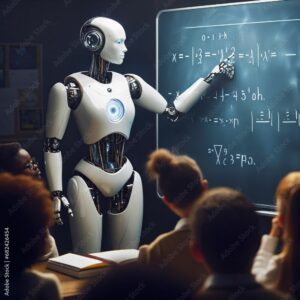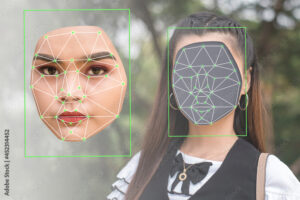AI: The wave of the future, or the tide wave of destruction?
Just as the internet reshaped the classroom, AI has levied the same predictions. As AI continues to solidify its place in our society, I worry about how it will be used and implemented, not only in our online world but in education. As a teacher, I see its benefits in education. However, I see not only a negative impact on students, but also a widespread misunderstanding of the role AI plays in comparison to the work of teachers. Many people believe that teaching is simply about passing on information and marking work; they believe that AI can easily replace educators. Unfortunately, these voices are often loud and come from positions of influence. Not only this, but students are also becoming increasingly reliant on this technology to complete their schoolwork. Without comprehensive regulation and policy creation, we may witness the gradual dismantling and degradation of education as we know it.
 AI has caused an impressive evolution in equitable online tutoring, virtual assistance in all subjects, and quick access to foundational knowledge. These are valuable resources for all students, but can be particularly beneficial for students who struggle with academics. AI can rephrase and simplify material, enabling students to ask questions without feeling embarrassed. With the absence of social vulnerability, students can potentially gain a deeper understanding and connection with the material. Some educators have stated that they have had success improving learning outcomes with the use of AI in their classrooms. Furthermore, AI can be a useful resource for students at home, particularly when parents are unable to assist their children with their homework.
AI has caused an impressive evolution in equitable online tutoring, virtual assistance in all subjects, and quick access to foundational knowledge. These are valuable resources for all students, but can be particularly beneficial for students who struggle with academics. AI can rephrase and simplify material, enabling students to ask questions without feeling embarrassed. With the absence of social vulnerability, students can potentially gain a deeper understanding and connection with the material. Some educators have stated that they have had success improving learning outcomes with the use of AI in their classrooms. Furthermore, AI can be a useful resource for students at home, particularly when parents are unable to assist their children with their homework.
At the same time, it’s easy for students to cheat using AI. With a single prompt, students can generate responses that meet specific requirements while mimicking their own writing style. This makes it harder for teachers to distinguish between student-produced work and AI-generated content. It is clear that this technological evolution is making us question what skills we believe to be important. As with all other technological advances, scholars have believed it to be a detriment to our skill set development. However, we have adapted and evolved. As with the evolutions before us, we are left to ask ourselves: Are these skills essential in an AI-driven future, or will they become obsolete? If these skills are becoming outdated, is it the responsibility of educators to decide what skills to focus on in the curriculum? The pace of government legislation and curriculum development is notoriously slow—often decades behind current needs—which leaves education systems vulnerable. This being said, some school divisions are independently creating policy to guide students and teachers with AI implementation.
That being said, AI threatens essential skill development, including critical thinking and problem-solving. When reproducing lengthy passages of text, AI is far from perfect. AI is notorious for presenting false information as fact. I have found this through my own experiences. For example, I once used ChatGPT to help connect two Bluetooth speakers. Despite online evidence that it was possible, ChatGPT repeatedly stated it was not. Only after referencing a specific website did it concede and offer helpful instructions. This is just one example of the issue AI has the potential to be utilized for manipulating facts and presenting harmful biases. If users unquestioningly trust AI, misinformation can spread quickly, especially in a society where critical thinking is not as widespread as we assume. In such a climate, AI could easily be used to manipulate public opinion. However, it is important to remember that AI is in its infancy. Its future potential has yet to be decided. Its future will be determined by what we do now. However, we are watching democratic norms begin to crumble in parts of the world. It is increasingly likely that the empowerment or oppression of AI may entirely depend on the corporations that control it. This again reiterates the need for comprehensive and responsible legislation regarding this influential technology.

The risks aren’t limited to academics. AI-generated content raises serious concerns about cyberbullying and deepfake content creation. Images and videos can be faked, voices cloned, and reputations ruined with disturbing ease. The damage from these incidents can be irreversible, especially with the prevalence of viral social media content and in the absence of legislation to protect victims. As AI-generated content becomes increasingly convincing, it will most likely become impossible to distinguish what’s real from what’s fake. This poses a threat not only to students but also to educators and the population.
Despite the risks, AI can be a time-saving administrative tool. It can help teachers efficiently generate resources, assessments, and differentiated materials. AI grading programs are also becoming more consistent, aiding teachers by identifying struggling students more quickly. Rather than sifting through stacks of assignments, educators can focus their attention where it’s needed most. With proper implementation, AI could reduce administrative burdens and allow teachers to spend more time supporting students. This could lead to a more engaging and inclusive classroom environment.
But the more pressing concern is the potential replacement of teachers. Currently, a pilot project in London, England, is testing the effectiveness of AI-driven classrooms. These private school students are learning via AI with only an assistant present in the room. This is the first trial of its kind. This program supports the arguments that AI is better at differentiating material and creating engaging content that caters to students’ interests. This pilot project could lead to the elimination of teachers if it is successful. Furthermore, programs like this risk widening the digital divide, because access will largely depend on wealth and location. Without careful consideration of ethical implications, these programs could reshape education without acknowledgment and development of the social and emotional skills obtained by students from the education system.
Canada has begun addressing the challenges of AI and the digital divide. The federal government has proposed legislation to establish a foundation for future regulations. The provincial governments are using federal grants to expand rural access to fibre-optic internet. However, during the debate, it was suggested that internet access is not a human right. Many argue that the internet is now so deeply integrated into society that it should be considered a fundamental right. Even the UN has determined that internet access is essential to society and is attempting to enshrine it in its Universal Declaration of Human Rights. However, the financial and logistical challenges of implementing widespread access—especially in rural areas—make this a complex and costly endeavour.
![]() The impact of AI on individuals with disabilities needs to also be addressed. Critical disability theorists warn that AI may reinforce ableist thinking by focusing on perceived deficits rather than enabling true accessibility. Furthermore, it perpetuates harmful stereotypes and discrimination by utilizing neurotypical assumptions in the development and implementation of this technology. This is possible by shifting the focus to the deficits people have and how technology can eliminate them, rather than creating environments that are universally accessible. It is also perpetuated in the source material used to train the AI model. If neurotypical source material is used, AI models fail to identify and accommodate the diverse needs of their users.
The impact of AI on individuals with disabilities needs to also be addressed. Critical disability theorists warn that AI may reinforce ableist thinking by focusing on perceived deficits rather than enabling true accessibility. Furthermore, it perpetuates harmful stereotypes and discrimination by utilizing neurotypical assumptions in the development and implementation of this technology. This is possible by shifting the focus to the deficits people have and how technology can eliminate them, rather than creating environments that are universally accessible. It is also perpetuated in the source material used to train the AI model. If neurotypical source material is used, AI models fail to identify and accommodate the diverse needs of their users.
Moreover, AI also mutes the voices of minorities. Due to its ability to siphon information (usually from westernized sources) and compile it into a summarized version, it does not differentiate between the lived experiences of minorities. It amalgamates their voice into one homogenized report. Due to this summation of information, the specific issues, history, culture and lived experiences are trivialized and ignored.
AI is here to stay. However, there are numerous issues with its implementation in society and education. AI policy, procedure, and ethical frameworks have yet to be firmly established by governing bodies. While inevitable growing pains are understandable, they do not eliminate the problems, misuse, and inequality we face today. Comprehensive and socially responsible regulation is essential. If AI remains unregulated, the future of education could be determined by private corporations that determine the quality of education students receive based on economic status.
Hi Sheila
Such a thoughtful and comprehensive post! You have dealt with almost every aspect.
AI definitely has its place. It can help teachers by handling administrative tasks, creating lesson materials, and supporting students who may not feel confident asking questions in class. It is a useful tool for making learning more accessible. However we can ignore the fact that students can easily misuse AI to complete their work, and it is not always accurate.
Even with all these advancements, AI can never replace teachers. Teaching is not just about sharing information. It is about emotional support, social development, and meaningful human connection. Can a machine truly understand and respond to those needs?
When used the right way, AI is just a tool in education it cannot be an ultimate end in classroom. The fact is that we need strong and clear policies to guide its use, so it remains a helpful tool rather than something that increases inequality or takes away the human part of learning.
Sarada
I wholeheartedly agree that AI cannot replace teachers. I feel that those who express this idea don’t fully understand the scope of a teacher’s job. A machine may be able to replicated these emotions, but it is only able to replicate what it can find as source material. How a person feels and thinks is complex and cannot be replicated authentically with source material.
One thing I am coming across in my personal readings (that I find poignant) is the rejection that Gen Z and Alpha are beginning to show towards technology. I have read that this generation is brining back “dumb” flip phones, cancelling magazine subscriptions if they find AI generated content, etc. I am interested to see if our fears and commentary regarding AI remains valid as time passes, or if these next generations will surprise us with how they “vote” with what they purchase.